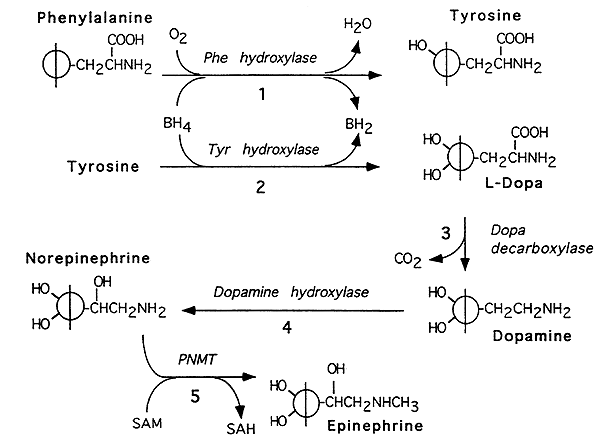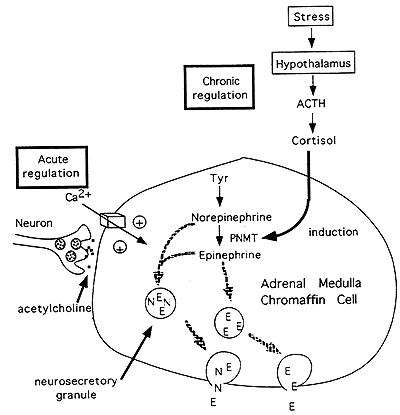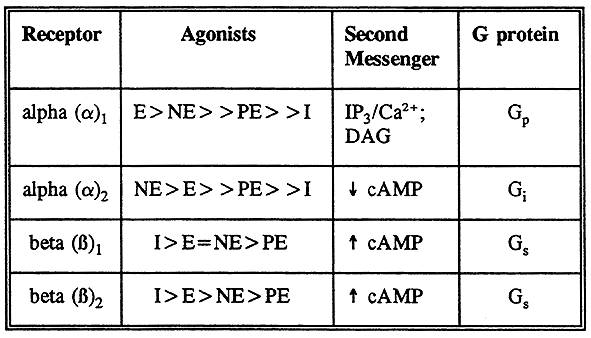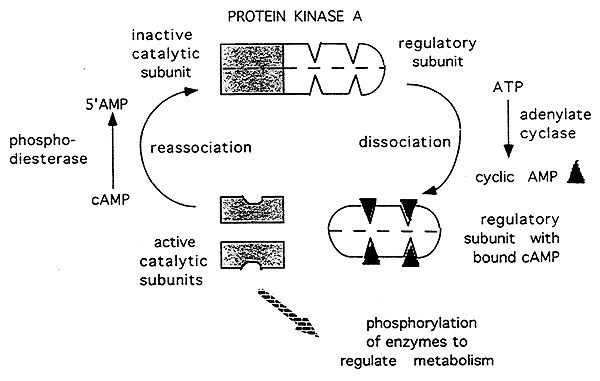
Catecholamines
Epinephrine (Adrenaline) and Norepinephrine:
The major elements in the "fight or flight" response.
The response to a threat involves an acute, integrated adjustment of many complex processes in the brain, muscles, heart and liver.
Epinephrine:
1. rapidly mobilizes fatty acids as the primary fuel for muscle action in addition to increasing muscle glycogenolysis.
2. mobilizes glucose as an energy source for the brain by increasing hepatic glycogenolysis and gluconeogenesis.
3. decreases insulin release to reduce glucose up-take by muscle and adipose tissues, thus preserving it for the central nervous system.
Biosynthesis:

Sites of Synthesis:
Epinephrine: Adrenal Medulla (part of the adrenal glands at the top of the kidneys).
Norepinephrine: made in situ on sympathetic (involuntary) nerve endings (stored in vesicles in termini of axons) and in the Adrenal Medulla. NE reaches target sites via circulation.
Regulation and Release:

Degradation:
-Catecholamines, including dopamine, are rapidly catabolized by catechol O-methyl transferase (COMT) and monoamine oxidase (MAO).
-A bewildering number of degradative intermediates from catecholamines are formed.....

Receptors:
Catecholamines act through two major clases of receptors designated a- or b- adrenergic.
Each consists of 2 subclasses, i.e. a1, a2, b1 and b2.

I = Isoproteranol, a synthetic catecholamine
Physiological / Biochemical Actions Mediated Through the Various Adrenergic Receptors:
| Process | a1 Receptor | a2 Receptor | b1 Receptor | b2 Receptor |
| CHO Metabolism | Increase Glycogenolysis (Liver) | No Effect | No Effect | Increase Glycogenolysis; Gluconeogenesis |
| Fat Metabolism | No Effect | Decrease Lipolysis | Increase Lipolysis | No Effect |
| Hormone Secretion | No Effect | Decrease Secretion of Insulin | No Effect | Increase Secretion of Insulin & Glucagon |
| Muscle Contraction | Smooth Muscle; Blood Vessels; Uribary Tract | Smooth Muscle; Vascular Beds; GI Relaxation | Myocardial: Increase Rate & Increase Force | Relaxation of Bronchi |
Three of these receptor subgroups are coupled to the adenylate cyclase system.
Hormones that bind to b1 and b2 receptors activate adenylate cyclase (2nd messenger).
Hormones that bind to a2 receptors inhibit adenylate cyclase.
Hormones that bind to a1 receptors effect intracellular calcium concentrations.
Cyclic AMP:

Cyclic AMP Activation of Protein Kinase A:

© Dr. Noel Sturm 2015